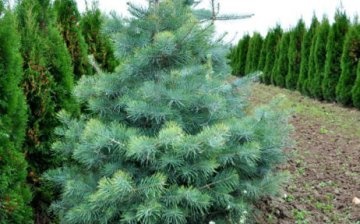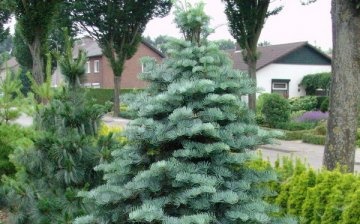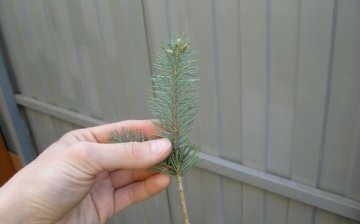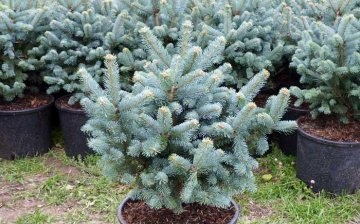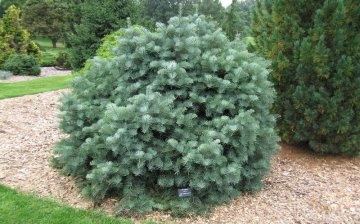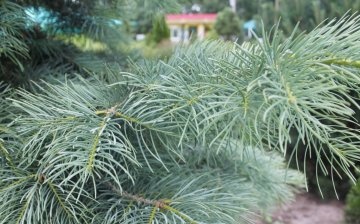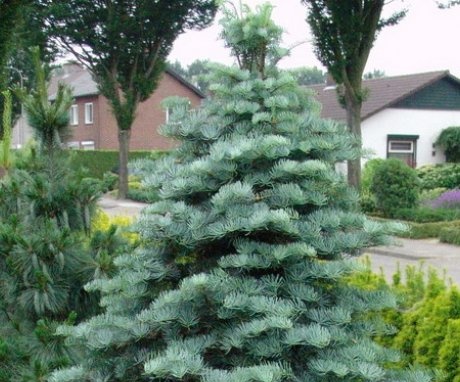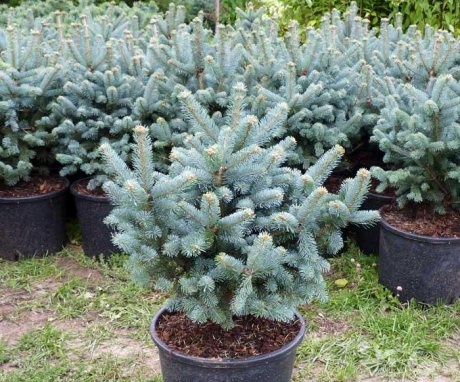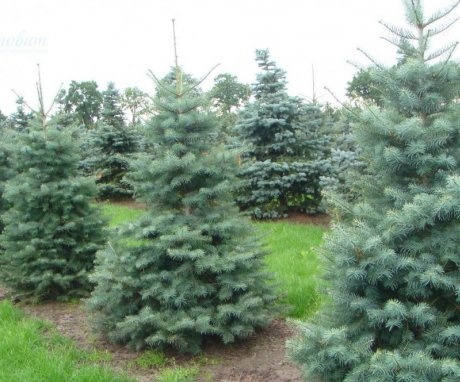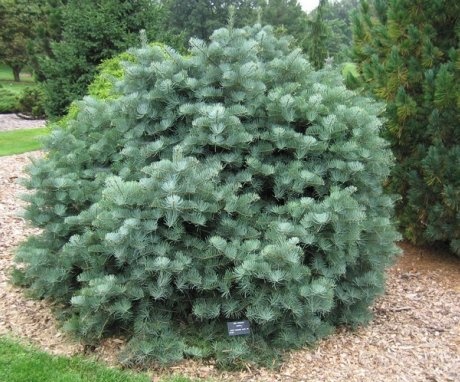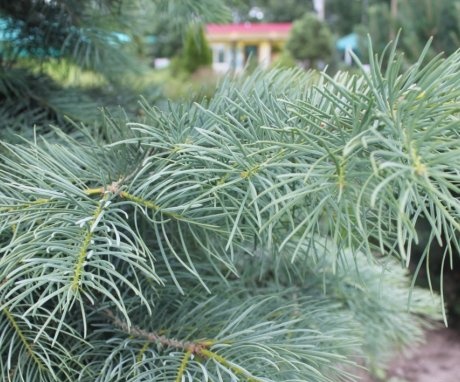Single-color fir: planting and caring for a coniferous plant
Monochrome fir (from Latin Abies concolor) is an evergreen tree from the Pine family. It received the specific name "one-color" due to its needles, painted on both sides in a gray-green color. The natural habitat of this luxurious tree is the western and northern regions of America.
It can be found in many European countries, Australia, Africa, as well as in the Far East and the Caucasus. Winter hardiness, unpretentious cultivation and resistance to metropolitan conditions, as well as a variety of varieties made fir a popular plant in many regions of Russia.
Content:
- Single-color fir and features of its structure
- Reproduction methods
- Planting a seedling: terms and rules
- Fir cultivation
- How to properly care for a fir?
- Where and how is fir used?
Single-color fir and features of its structure
Monochromatic fir Is a massive tree, sometimes reaching 60 meters in height. Its trunk is about 2 meters in diameter, and the crown has a conical shape, rather dense at the beginning of growth and slightly drooping and thinning in adulthood. The bark of the fir is gray and smooth, has longitudinal grooves, its thickness in an adult tree is 10-13 cm.
Skeletal branches are located at right angles to the trunk of the fir, and already on them there are branching branches, they are smaller and directed in all directions. The buds reach 6 cm in length, they are yellowish-green in color and very resinous.
The needles of a single-colored fir are flat, more blue than green, and have light lines at the edges.
They are sickle-curved and asymmetrically located on the branch. Their length depends on the type of plant, it is on average 1.5 -5 cm, width is about 2 mm. The male strobili are red and purple, while the female strobili are gray-green.
The coniferous tree is famous for its large oval and slightly cylindrical cones up to 10 cm long and up to 5 cm wide. Young they are light green, later darken to beige, and only then, when fully ripe, they become deep brown. The cone scales contain brown seed grains.
Reproduction methods
In natural conditions, fir reproduces seeds... Its ripe buds open and the seeds are carried by the wind over a fairly wide distance. But with self-planting, its seeds should be sown thickly: 10 seeds per hole. Spring shoots, as a rule, do not exceed 50% of planted seeds. Seedlings do not need to be transplanted for a long time - from 2 to 4 years.
Fir seeds are not easy to harvest. Cones in mature trees are very high and when ripe, the seeds immediately fly in different directions. But you can also use an unripe cone, for this you need to dry it a little, so it will be easier to get seed grains. You need to store them before planting in a cool place with high humidity, a refrigerator or basement is suitable for this.
Seeds must be stratified prior to planting.
Seed stratification occurs at an optimal temperature of + 1C for about a month, but it is believed that seeds germinate in the light rather faster.The autumn planting of freshly harvested seeds reaches the germination rate of 60 to 80%, and the spring planting - about 30%.
Seed stratification:
- first, the seeds are soaked overnight so that they gain moisture, then they are disinfected for about 20 minutes in medium diluted potassium permanganate, then washed several times in clean water
- take a glass of sand and warm it up well in the oven (to eliminate germs)
- after cooling, sand and seeds are mixed in a 1: 5 ratio (one is seeds)
- this mixture must be poured into a jar and well moistened
- the jar must be placed in a cool place
- Shake the contents of the jar for 15 days and moisturize if necessary
If fir seeds hatch earlier than planned, then they can be planted in seedling pots and planted in the ground at the scheduled time, like any other seedlings. Fir species can be propagated using seeds harvested at the beginning of the ripening of the cones.
Decorative species reproduce by cuttings:
- Cuttings are taken exclusively from young annual shoots with one apical bud and heel. To do this, you can not cut off the stalk, but tear it off along with a piece of bark. The stalk is taken in early spring in damp weather from the north side of the middle of the crown, its length should be about 8 centimeters.
- After collecting, the cuttings are processed for several hours in a weak solution of potassium permanganate (to avoid fungus), and only then are planted in a soil mixture of humus, sand and peat (in equal proportions).
- Cover pots with cuttings with transparent bags or plastic flasks and put in a bright place. The cuttings need to be ventilated every day.
Cuttings take root long enough, callus will first appear, and only then, only after a year, the root system will begin to develop. After sufficient root development, the stalk, or rather the seedling, can be planted in the ground in a permanent place. For mass planting, the density of fir planting should not exceed 800 to 3000 trees per hectare.
Planting a seedling: terms and rules
For planting fir of this variety in the ground, seedlings are needed at least four years of age. Spring planting can be done in April, and in autumn in September. For this, it is better to choose a cloudy or even rainy day.
You need to choose a place for it that is spacious, well-lit with moderately moist, drained soil, loam will be the best option. Planting of a single-colored fir is carried out directly with an earthen clod in which the root grows. Incorrect root pruning will greatly reduce the chance of a tree rooting quickly in a permanent location.
Landing rules:
- To plant fir, you need to dig a hole in advance that will correspond to the root of the seedling, this is an average of 70x70x70.
- You need to pour 2 buckets of water into the pit, when it is completely absorbed into the recess, you need to pour a small (up to 6 cm) layer of rubble.
- Only now it is possible to fill the pit up to half with soil consisting of humus, clay, sand and peat, sawdust and nitrophoska are added there. The ratio must be adjusted depending on the condition of the main soil of the site.
- After a couple of weeks, the soil should settle. Now you can lower the seedling into this hole along with the lump, its root collar should be at the level of the surface of the site.
- After that, the pit is filled with the remaining soil and compacted (with the formation of a small hole for irrigation) and watered.
If the seedlings are planted in a row, the distance between them should not be less than 4-5 meters. For a group landing, the distance may be less - about 3 meters.
Fir cultivation
This view fir unpretentious to many types of soil, it adapts to different structures, any acidity and nutritional value. However, the tree does not tolerate excess moisture. Fir grows well on loose, moderately acidic, drained soil, as well as on parent rocks of andesite, pumice, shale or sandstone.
Monochrome fir is considered the most drought-resistant among all other varieties that are cultivated in Russia; it tolerates cold winters and winds very well.
Its late blooming buds are not in danger of perishing from frost. The plant loves light, but it can grow in a shaded place, very quickly adapts to the conditions of the city and to various specific environmental factors.
Japanese scientists, on the basis of their research, argue that the maximum frost resistance of winter fir shoots can correspond to -35 ° C, and the upper buds and needles tolerate higher frosts. In Russia, fir is cultivated everywhere, but it bears fruit best of all in its western part and in the Caucasus.
How to properly care for a fir?
The coniferous beauty has rightfully earned popularity among amateur gardeners. Its delicate green of needle-like leaves and amazing coniferous aroma will not leave indifferent anyone who has seen this miracle at least once.
Care Tips:
- The planted plant needs soil moisture, once every 15 days will be enough. Later, it is necessary to water the fir only during the drought period. She does not need artificial watering, rainfall is enough for her.
- A young and still fragile tree planted needs protection from gusty winds, so it needs to be tied to a support.
- Excessive direct rays can also harm the plant, so partial shade will be the best place for a seedling.
- Once the plant is rooted, you can fertilize it. It is better to fertilize a tree after winter or in autumn with specially designed means, for example,Kemira station wagon».
- Early in the spring, it is necessary to carry out prophylaxis for the processing of fir with compositions from possible pests. For this, pesticides and fungicides with a wide spectrum of action are used.
- Pruning of this type of fir is carried out in the spring, before the start of sap flow. It is necessary to remove dry, damaged and diseased branches, eliminate unnecessary thickening and, if necessary, form a crown. Pruning is done with garden shears. When trimming, the shoots should be shortened by no more than a third of the length.
- As for wintering, the monochromatic fir easily tolerates winter and its frosts. Young plants, especially autumn seedlings, of course, need to be looked after. It is better to mulch the trunk circles with peat and dry foliage, and the tree itself can be covered with spruce branches. Mature trees do not require winter shelter, and they can be protected from the bright spring sun with a special non-woven fabric.
Fir is an unpretentious tree, it easily tolerates cold and drought, and is resistant to many diseases and pests. But sometimes the crown of a tree can lose its rich decorative appearance due to aphids (in this case - spruce-fir hermes).
If stellate or chickweed plants grow next to the fir, they need to be removed.
Yellowed fir branches can be treated with Antio or Rogor. This should be done in early spring in order to have time to neutralize the overwintered female aphids. Insecticides will destroy other insects - shoot moth or pine cone. If the needles are affected by fungi or rust, diseased branches must be cut and burned, and the cuts must be covered garden pitch... The crown can be sprayed with diluted bordeaux liquid.
Where and how is fir used?
Monochrome fir is very often used in landscape design, it can be found in many parks and squares, since the variety is rightfully considered the most beautiful and fragrant among all coniferous plant species.
The coniferous plant is used to improve many design ideas:
- Fir is often combined with deciduous trees, especially for contrasting plant colors. She looks great when planted with larch, maples, birches and many shrubs.
- Monochrome fir is used to create hedge, they decorate alleys and flower beds with it, and also plant it as an independent tree near the house to shade the site.
In a cut branch of fir, the needles do not crumble for a long time, therefore it is widely used in floristry. The aroma of her oil is used in cosmetology, in folk medicine, in particular aromatherapy. It is an excellent natural antidepressant and antiseptic.
Fir resin is often used for medicinal purposes, it is used to treat coughs, bronchitis, sore throat and even tuberculosis.
It is used to treat otitis media, with all kinds of mucous inflammations, as well as many urogenital diseases, scurvy, rheumatism, muscle and joint diseases. Most of the drugs that contain fir, strengthen the immune system, stimulate hematopoiesis, replenish the body with vitamins and other useful substances, relieve stress and protect against radiation.
More information can be found in the video:



